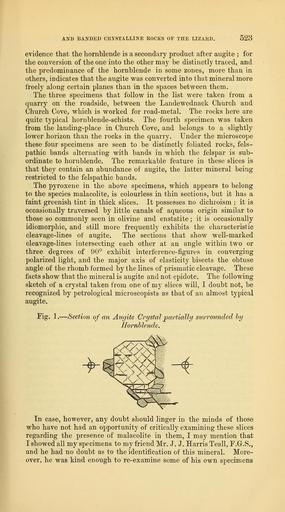MAKE A MEME
View Large Image

| View Original: | The_Quarterly_journal_of_the_Geological_Society_of_London_(13960517673).jpg (1166x2096) | |||
| Download: | Original | Medium | Small | Thumb |
| Courtesy of: | commons.wikimedia.org | More Like This | ||
| Keywords: The Quarterly journal of the Geological Society of London (13960517673).jpg AND BANDED CRYSTALLINE ROCKS OF THE LIZARD 525 <br> they were subjected to severe crushing Moreover it is evident <br> that the very existence of cracks and fractures shows that the rocks <br> which now display these marks of strain must have been rigid when <br> the fractures took place and their continued presence demonstrates <br> that the dynamic heat developed was insufficient to induce recrystal- <br> lization <br> Whatever may be said of other rocks I find it impossible to <br> account for the fine banding of the hornblende-schists on the <br> supposition that these bands were produced by a series of sliding <br> planes Not only would the regular succession and alternation of <br> these thin bands present a serious objection to the acceptance of <br> this explanation but it is obvious that the shearing of a solid rock <br> into such extremely thin layers would have developed heat sufficient <br> to fuse the whole mass in which case it would have lost its banded <br> structure and have assumed that of a hornblende-granite The <br> stripes are so sharply defined and thin that several of them can be <br> seen in a slice mounted on an ordinary microscopic slide The <br> supposition that these bands were originally thick and were drawn <br> out into streaks of thread-like thinness by stretching is not sup- <br> ported by the microscopic evidence and it fails to explain how the <br> hornblende segregated into a series of parallel zones The felspars <br> that make up the base of the rock do not exhibit in their orienta- <br> tion or shapes the marks of stretching and deformation which are <br> strikingly displayed in some of the foliated gabbros of the Lizard <br> The rock is not composed of thin shavings of two or more different <br> rocks ; the microscope shows that there is no difference in substance <br> or structure between the base of the white and the base of the <br> black bands ; the rock seems to have originally been a homogeneous <br> one and the banding to have been produced at a later stage in its <br> history by the segregation of the hornblendic element in planes <br> parallel to the bedding The main question seems to me to be <br> How has this segregation of hornblende been produced <br> One of the most important agents in bringing about the banding <br> of the Lizard hornblende-schists appears to me to have been water <br> The rocks themselves when interrogated with the aid of the micro- <br> scope give abundant evidence of the presence and action of water <br> and the competence of this agent aided by heat and pressure to <br> bring about great mineralogical and structural changes can hardly <br> be doubted Indeed the Lizard rocks have been penetrated by <br> and have yielded to the action of aqueous influences so completely <br> that they may almost be said to have been stewed in water The <br> Lizard serpentine which covers so large an area and which still <br> bears on its bosom so many traces of the potent agent that reduced <br> this ancient peridotite to its present condition may be appealed to <br> with confidence to prove the truth of this assertion <br> Water ” and I omit for brevity sake all allusion to the carbon <br> dioxide and other chemical reagents with which it is usually charged <br> ” appears to penetrate rocks through such fine pores that more <br> often than otherwise its former presence can only be inferred from <br> See also Bonney ante 36940354 113696 51125 Page 523 Text 45 http //www biodiversitylibrary org/page/36940354 1889 Geological Society of London Biodiversity Heritage Library The Quarterly journal of the Geological Society of London v 45 1889 Geology Periodicals Smithsonian Libraries bhl page 36940354 dc identifier http //biodiversitylibrary org/page/36940354 smithsonian libraries Information field Flickr posted date ISOdate 2014-04-21 Check categories 2015 August 26 CC-BY-2 0 BioDivLibrary https //flickr com/photos/61021753 N02/13960517673 2015-08-26 05 52 05 cc-by-2 0 PD-old-70-1923 The Quarterly journal of the Geological Society of London 1889 Photos uploaded from Flickr by Fæ using a script | ||||